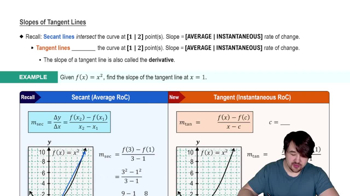Table of contents
- 0. Functions7h 52m
- Introduction to Functions16m
- Piecewise Functions10m
- Properties of Functions9m
- Common Functions1h 8m
- Transformations5m
- Combining Functions27m
- Exponent rules32m
- Exponential Functions28m
- Logarithmic Functions24m
- Properties of Logarithms34m
- Exponential & Logarithmic Equations35m
- Introduction to Trigonometric Functions38m
- Graphs of Trigonometric Functions44m
- Trigonometric Identities47m
- Inverse Trigonometric Functions48m
- 1. Limits and Continuity2h 2m
- 2. Intro to Derivatives1h 33m
- 3. Techniques of Differentiation3h 18m
- 4. Applications of Derivatives2h 38m
- 5. Graphical Applications of Derivatives6h 2m
- 6. Derivatives of Inverse, Exponential, & Logarithmic Functions2h 37m
- 7. Antiderivatives & Indefinite Integrals1h 26m
- 8. Definite Integrals4h 44m
- 9. Graphical Applications of Integrals2h 27m
- 10. Physics Applications of Integrals 2h 22m
3. Techniques of Differentiation
The Chain Rule
Problem 94a
Textbook Question
Tangent lines Assume f is a differentiable function whose graph passes through the point (1, 4). Suppose g(x)=f(x²) and the line tangent to the graph of f at (1, 4) is y=3x+1. Find each of the following.
a. g(1)
 Verified step by step guidance
Verified step by step guidance1
Step 1: Understand the problem. We are given a function g(x) = f(x^2) and need to find g(1). We know that f is differentiable and passes through the point (1, 4), and the tangent line to f at (1, 4) is y = 3x + 1.
Step 2: Evaluate g(1). Since g(x) = f(x^2), we substitute x = 1 into g(x) to get g(1) = f(1^2) = f(1).
Step 3: Use the information about f. We know that the graph of f passes through the point (1, 4), which means f(1) = 4.
Step 4: Conclude the evaluation. Since f(1) = 4, we have g(1) = f(1) = 4.
Step 5: Summarize the result. Therefore, g(1) is equal to 4.
 Verified video answer for a similar problem:
Verified video answer for a similar problem:This video solution was recommended by our tutors as helpful for the problem above
Video duration:
1mPlay a video:
Was this helpful?
Key Concepts
Here are the essential concepts you must grasp in order to answer the question correctly.
Differentiable Functions
A differentiable function is one that has a derivative at every point in its domain. This means that the function is smooth and continuous, allowing for the calculation of slopes of tangent lines at any point. The existence of a derivative indicates that the function can be locally approximated by a linear function, which is essential for understanding tangent lines.
Recommended video:

Finding Differentials
Tangent Lines
A tangent line to a curve at a given point is a straight line that touches the curve at that point and has the same slope as the curve at that point. The equation of the tangent line can be derived using the point-slope form, which incorporates the derivative of the function at that point. In this case, the tangent line to f at (1, 4) is given as y = 3x + 1, indicating that the slope at that point is 3.
Recommended video:

Slopes of Tangent Lines
Composition of Functions
The composition of functions involves combining two functions where the output of one function becomes the input of another. In this problem, g(x) = f(x²) represents a composition where the input x is squared before being passed to function f. Understanding how to evaluate g(1) requires substituting 1 into the composition and then determining the value of f at the resulting input.
Recommended video:

Evaluate Composite Functions - Special Cases

 5:02m
5:02mWatch next
Master Intro to the Chain Rule with a bite sized video explanation from Callie
Start learningRelated Videos
Related Practice







